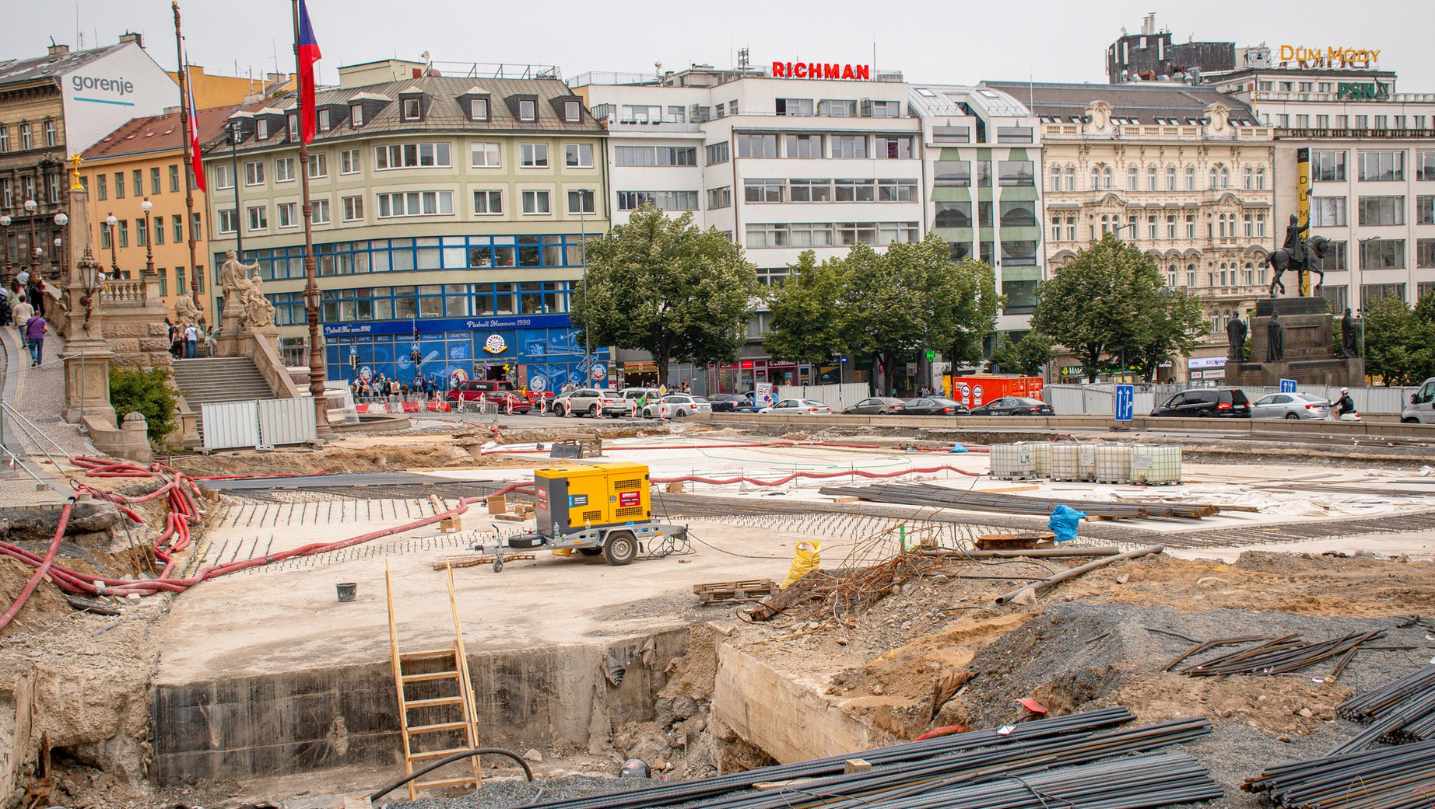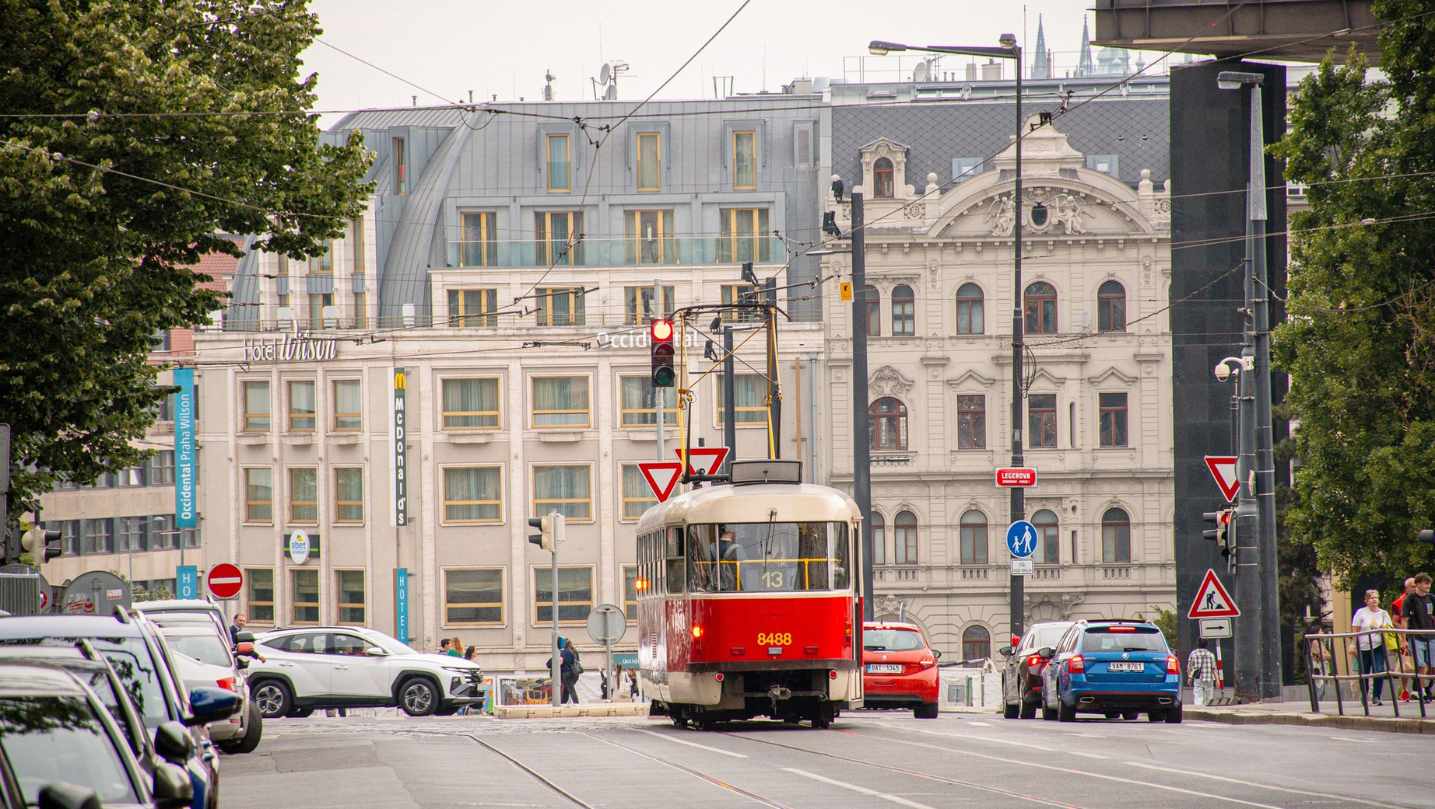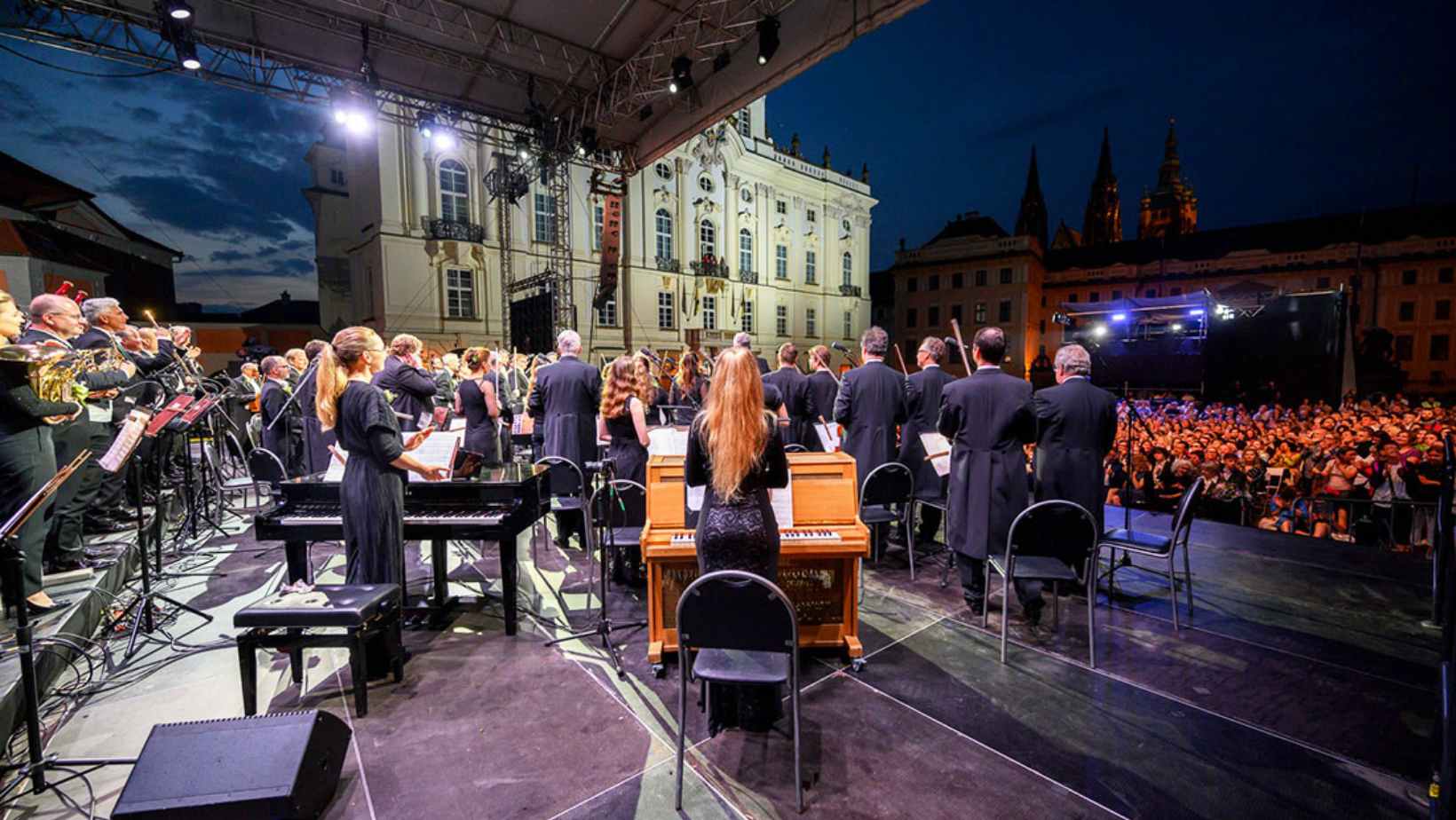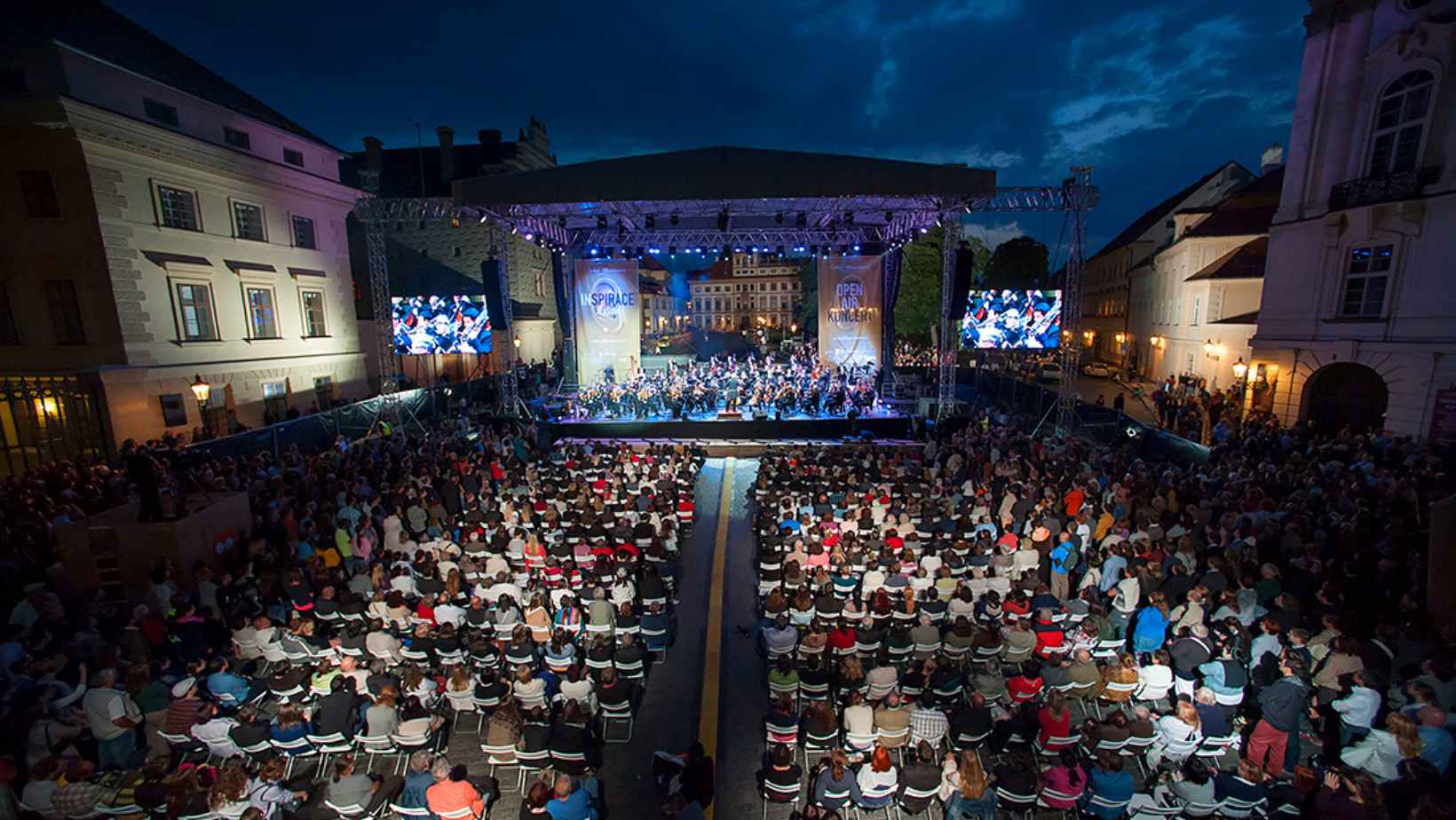From July 26 to August 1, Prague’s Masaryk Station will be completely closed to allow the Railway Administration to activate new signaling systems as part of ongoing modernization efforts.
During this time, trains will be rerouted to other stations, primarily the Main Station (Praha hlavní nádraží).
Travelers planning trips in late July should check updated schedules carefully, as no trains will serve Masaryk Station throughout the week.
“The Railway Administration is continuing its modernization work, and the activation of the new signaling equipment will begin on Saturday, July 26. Train service is expected to resume on the evening of August 1, alongside the reopening of the upgraded section between Bubny and Výstaviště,” said Nela Eberl Friebová, the Railway Administration’s spokesperson.
Meanwhile, extensive construction is underway at Masaryk Station itself. A new platform is being built above the tracks, and new covered platforms for tracks 8 and 9 near Na Florenci Street are under development.
These platforms are scheduled to open to passengers by mid-December, improving the station’s capacity and comfort.
The Main Station will also see temporary closures during the first weekend of August. On August 2 and 3, maintenance work will take place, leading to adjusted schedules for several regional and long-distance Czech Railways lines.
Would you like us to write about your business? Find out more
Prague City Tourism (PCT) has launched a new online educational campaign aimed at foreign visitors.
Titled Enjoy Respect Prague, the campaign seeks to educate tourists about local rules, responsible behavior, and how to avoid illegal or unofficial services in the city.
The campaign delivers its message through a series of short, humorous video clips. These videos explain how visitors can explore the city respectfully, without disturbing daily life for the city’s over one million residents.
“We want tourists in Prague to feel welcome, but at the same time understand that they’re moving through a living city where people work, live, and raise children,” said Jana Adamcová, Vice Chairwoman of the PCT Board of Directors. “Our goal is for tourists and locals to share public space considerately. That’s why we created the ‘Ten Commandments’ for visitors.”
The online rollout builds on the existing outdoor campaign, now in its third year, visible at Prague Airport and across the city center.
The campaign touches on key topics such as observing quiet hours at night, avoiding graffiti or damage to historical monuments, and using licensed city guides.
Tourists are also encouraged to explore non-touristy neighborhoods like Holešovice, Karlín, and Vinohrady, use public transport, and support local businesses by purchasing Czech-made products and specialties.
Another important theme is animal protection. The campaign warns against illegal street offers where tourists pay to pose for photos with exotic animals, a practice described as both unethical and illegal.
The initiative is part of a broader strategy by Prague to promote sustainable tourism, following guidelines from the United Nations World Tourism Organization (UN Tourism). Like other European capitals, Prague is shifting towards “slow tourism”, focusing on quality over quantity.
In recent years, the city has intensified efforts to combat overtourism and alcohol-fueled party tourism. Measures have included banning organized pub crawls and targeting marketing campaigns at travelers aged 35 and over, a group viewed as more interested in cultural and historical experiences.
Tourists can find the full Ten Commandments for Visitors and additional information on the city’s official tourism website.
Would you like us to write about your business? Find out more
The Czech Philharmonic Orchestra will host its traditional free open-air concert this Thursday, June 19, marking the close of the 2025 music season.
The performance will take place at Hradčany Square, directly across from Prague Castle.
The concert begins at 20:15 and will last around 70 minutes. Admission is entirely free of charge, with no tickets required. Visitors are encouraged to arrive early to secure a spot, especially as seating is limited.
This year’s event will be conducted by Dalia Stasevska, with a rich program that blends French classical works with celebrated pieces by Czech composers. The concert will also include a world premiere by Czech composer Jiří Gemrot.
To ensure accessibility, the organizers have arranged 700 reserved seats, primarily for seniors, people with disabilities, and expectant mothers. Other attendees are welcome to bring blankets or cushions and enjoy the show from the cobblestones or nearby lawn.
Program Highlights:
Bohuslav Martinů — Overture for Orchestra H 345
Leoš Janáček — Lašské Dances: Starodávný II, Čeladenský
Maurice Ravel — Pavane for a Dead Princess, Bolero
Lili Boulanger — D’un matin de printemps
Georges Bizet — Danse Bohéme and Nocturne from Carmen Suite No. 2
Jiří Gemrot — Pauliana for clarinet and symphony orchestra (world premiere)
The Czech Philharmonic is the country’s most respected orchestra, with a history dating back 129 years. In 2008, it was ranked among the 20 best orchestras in the world by Gramophone magazine.
Its current home is the Rudolfinum, but by 2032, the ensemble is set to move to a new state-of-the-art concert hall approved by Prague authorities.
Would you like us to write about your business? Find out more
Starting Saturday, June 14, Prague’s public transport system will enter a complicated phase of reconstruction that will reshape travel through the I. P. Pavlova and Muzeum area for nearly three years.
The city’s transport authority has announced major changes to tram routes and stops that will remain in place until March 2027.
The initial closure phase begins at midnight on Saturday and ends early Monday morning, June 16. During this time, crews will begin work on a new tram crossing at Vinohradská Street, setting the stage for the broader reconstruction effort.
As a result, tram line 11 will be rerouted along a new path:
Spořilov – I. P. Pavlova – Náměstí Míru – Šumavská – Vinohradská vodárna – Perunova – Orionka – Flora – Spojovací.
Meanwhile, line 13 will be completely canceled during this phase.
Two-way tram stops will be temporarily created at Tylovo náměstí, replacing the I. P. Pavlova stop. For night tram services heading to the Main Station, the Muzeum stop will move about 50 meters further down Legerova Street, past the intersection with Vinohradská.

Long-Term Changes Begin After June 16
Once the Vinohradská crossing is completed, Prague will move into the core reconstruction phase, which is expected to last until March 2027.
Tram line 11 will continue to operate on the adjusted route mentioned above for the duration of the works. However, line 13 will reappear with a shortened route, serving only the following stops: Olšanské hřbitovy – Flora – Jiřího z Poděbrad – Muzeum.
There will also be permanent changes to tram stops: I. P. Pavlova will remain shifted to Tylovo náměstí in both directions.
The Muzeum stop will now serve as a boarding and alighting point on Vinohradská Street, near its intersection with Španělská Street.
Passengers are advised to plan routes in advance, check real-time updates using the PID Lítačka mobile app, and consult maps and closure notices available at pid.cz.

Would you like us to write about your business? Find out more
Starting this June, a new direct train service from Poland to Croatia will begin operations — and it will pass through the Czech Republic, Austria, and Slovenia.
The announcement came from Polish Prime Minister Donald Tusk, who shared the news on Sunday via the social platform X.
“Finally, we have a direct train connection from Poland to Croatia! We will start in June, four days a week. Details will be announced on Tuesday,” Tusk posted on the same day Poland held the first round of its presidential elections.
The long-awaited route will be operated by PKP Intercity, Poland’s largest passenger train provider. The company had already signaled in April that it was prepared to launch the connection, but was waiting for approval from the transit countries.
Jest taka cisza, że chyba każdy usłyszy tę dobrą nowinę: mamy wreszcie BEZPOŚREDNIE połączenie kolejowe z Polski do Chorwacji! Ruszamy od czerwca, cztery dni w tygodniu. Szczegóły we wtorek.
— Donald Tusk (@donaldtusk) May 18, 2025
The new route will further strengthen ties between Czechia and Poland, expanding recent rail developments. Earlier this year, Czech Railways, in cooperation with Polish Railways, launched the Ex32 line, connecting Prague–Pardubice–Wrocław–Gdynia.
Now, this new Croatia-bound line will allow Czech travelers to reach the Adriatic coast without needing to change trains — a welcome option after RegioJet failed to offer its seasonal direct service to Croatia last summer.
The complete timetable and ticketing details are expected to be revealed soon.
Would you like us to write about your business? Find out more
Uber has launched a new courier service in Prague, allowing residents to send parcels across the city with ease and transparency.
The delivery process works much like booking a ride—users can schedule pickups directly in the Uber app, and they’ll know the price in advance, regardless of the parcel’s size or weight, as long as it meets the service conditions.
According to a statement from the company, the cost of using the courier service will be comparable to UberX, Uber’s most affordable ride option.
To use the service, the sender simply selects “Courier” in the Uber app, agrees to the terms, and enters key information such as the recipient’s name and drop-off address. The sender then meets the driver at a selected pickup location to hand over the parcel.
Once dispatched, both sender and recipient can track the package in real-time via the app. Even if the recipient doesn’t have the Uber app, they’ll receive an SMS link to follow the parcel’s journey. When the delivery is completed, both parties are notified automatically.
The new service comes with some restrictions. Packages must not exceed 15 kilograms, and their value must be under 2,500 CZK. Items such as weapons, alcohol, drugs, prescription medications, cash, and perishable goods are prohibited.
For now, the service is available only in Prague, but Uber plans to roll it out in other Czech cities where it operates. “Drivers will benefit from this new feature, as it gives them an opportunity to boost their earnings by handling package deliveries,” said Štěpán Šindelář, Uber’s operations manager for the Czech Republic.
Uber has been present in Prague since 2014 and has since expanded to Brno, Ostrava, Pilsen, Olomouc, Hradec Králové, and Pardubice.
It faces competition from other ride-hailing and delivery platforms in the Czech Republic, including Estonia-based Bolt and local startup Liftago, both of which offer similar services. Liftago also provides courier deliveries, while Bolt operates a food delivery platform.
Would you like us to write about your business? Find out more
After nearly a year of renovations, the Prague Planetarium is set to reopen on Saturday, June 14, now boasting the most advanced projection technology in Europe—and one of the most sophisticated in the world.
The planetarium’s transformation centers around its new LED Dome, a €12 million upgrade that replaces traditional projection systems with ultra-high-definition, immersive visuals.
“We’re planning a special program for the opening weekend, June 14 and 15, to welcome visitors back,” said director Jakub Rozehnal. “Guests can look forward to a 15-minute show running in cycles throughout both days, discounted tickets, and a small souvenir to commemorate the occasion.”
From Monday, June 16, the planetarium will resume its regular schedule, offering a broader selection of programming. “We’ve acquired new educational films and are currently finalizing their translations and dubbing,” Rozehnal added. “We’ll include whatever is ready by then.”

New Standard in Planetarium Technology
The overhaul, which began in summer 2023, was fully funded by the City of Prague at a total cost of 300 million CZK. The crown jewel is the LED Dome, valued at 180 million CZK, measuring 22 meters in diameter.
Unlike traditional systems that use spherical projectors and fabric screens, the new dome incorporates 45.3 million micro-LEDs, offering unprecedented image quality, contrast, and brightness at 8K+ resolution.
The technology—developed by American company Cosm—represents a leap in immersive educational experiences.
“Prague is now home to the most advanced planetarium technology available,” said representatives from Cosm. “With the CX System, including Digistar 7 and integration with Unreal Engine, visitors will experience some of the world’s most realistic astronomical simulations and scientific visualizations.”

Built to Last—and Pay Off
City officials are confident the investment will pay for itself. In 2019, before the pandemic, the planetarium drew 200,000 visitors, a number expected to grow significantly after the upgrade. The LED Dome, with a life expectancy of 25 years, also reduces long-term operational costs.
To manage the intense heat generated by the LED system, a new ventilation and energy recovery system has been installed. Waste heat from the diodes will be reused to heat the building, improving the facility’s energy efficiency.

Expanded Capacity and Offerings
The planetarium’s auditorium capacity has been expanded from 190 to 280 seats, and new amenities include a souvenir shop, cloakroom, and a redesigned pass-through layout that facilitates visitor flow.
More than just a place to gaze at stars, the renovated space is designed for versatile programming. In addition to astronomy shows, it will host educational films, concerts, and theatrical performances. Rozehnal emphasized the goal of attracting “a broad audience, across all age groups.”
Originally opened in 1960, the Prague Planetarium features one of the world’s largest domes, measuring 23.5 meters. With this ambitious renovation, it’s now ready to lead the next generation of science and culture in Europe.
Would you like us to write about your business? Find out more
As many as 260,000 refugees from Ukraine could remain in the Czech Republic permanently within the next decade, according to a new study by Boston Consulting Group (BCG) and the Aspen Institute Central Europe.
If that estimate proves accurate, the total number of foreigners in the country could reach 1.36 million by 2035.
As of the end of March, figures from the Ministry of the Interior showed that 364,600 people were living in Czechia under temporary protection. Another 708,700 foreign nationals held various types of residence permits—bringing the total to around 1.07 million.
“We currently estimate that around 70% of Ukrainian refugees will remain in the Czech Republic after 2035,” the study’s authors wrote. However, they noted that much depends on how the war in Ukraine develops in the coming years.
The study highlights a generally positive effect on the Czech labor market, which has long suffered from worker shortages.
“The arrival of labor helped ease shortages in sectors like construction, manufacturing, and services, while also generating new consumer demand that supported parts of the economy,” the study notes.
But integration is not without challenges. The report flags several issues: language barriers, the limited recognition of qualifications, and increased pressure on the healthcare and social systems.
By the end of March, Czechia had registered 364,602 people with temporary protection. Additionally, 330,283 people held temporary residence, while 378,418 had permanent residency.
If current trends hold, the study predicts that the number of foreign residents could rise to 1.19 million by 2030 and reach 1.36 million by 2035. Of those, 260,000 would be Ukrainian refugees, many with children who would gradually enter the workforce.
“We expect that the number of foreigners in the Czech Republic will increase. We will need them. Even with that growth, our economy will still face labor shortages,” said Tomáš Wiedermann, BCG partner and one of the study’s co-authors.
Alongside those fleeing war, another 90,600 Ukrainians live in Czechia with temporary residence.
A further 111,700 Ukrainians have obtained permanent residency after meeting long-term stay requirements. The study estimates that the Ukrainian immigrant population could rise to around 237,000 by 2035.
Would you like us to write about your business? Find out more
SunExpress is launching a new direct seasonal route between Prague and Izmir, Turkey’s third-largest city.
The flights will operate twice a week, on Wednesdays and Sundays, from June 5th to September 29th, 2024.
Affordable Travel with Checked Baggage Included
Tickets are already available for purchase, with one-way fares starting from a budget-friendly CZK 3,000. This price includes a checked baggage allowance of up to 30kg, eliminating the need for additional fees.
The flight time is approximately 2 hours and 35 minutes. Departures from Prague will be at 9:40 PM, while flights from Izmir will take off at 7:00 PM.
SunExpress will operate the route using Boeing 737-800 or 737 MAX 8 aircraft, both configured to comfortably seat 189 passengers.
Additional Option: Smartwings Enters the Market
Starting May 30th, Czech airline Smartwings will also offer flights between Prague and Izmir. Their service will operate on Mondays and Thursdays.
However, it’s important to note that Smartwings’ one-way fares start from CZK 4,900 and do not include checked baggage in the base price.
Located on the eastern coast of the Aegean Sea, Izmir boasts a population of 2.96 million, making it Turkey’s third-largest city.
Surrounded by rolling hills, the city enjoys a typical Mediterranean climate with warm, dry summers and mild, rainy winters.
Would you like us to write about your business? Find out more
The Czech Republic’s consumer price inflation eased more-than-expected in January to the lowest level in nearly three years, largely due to a sharp slowdown in utility costs along with a continued fall in food costs, data from the Czech Statistical Office shows.
Consumer prices climbed 2.3 percent year-over-year in January, much slower than the 6.9 percent rise in December. Meanwhile, economists had expected inflation to slow to 2.9 percent.
Further, this was the weakest inflation since March 2021, the agency said.
The annual price growth in utilities eased markedly to 3.1 percent in January from 16.8 percent in December.
The decline in prices of food and non-alcoholic beverages deepened to 3.9 percent from 0.3 percent.
Meanwhile, transport charges rebounded 0.4 percent after a 0.2 percent drop seen in December. On a monthly basis, consumer prices rose 1.5 percent in January, versus an expected increase of 2.0 percent.
The monthly upturn was mainly attributed to higher utility costs, especially electricity charges.
The Czech Defence Ministry and local industry have identified 800,000 units of available ammunition that could be delivered to Ukraine within weeks, if funding are secured.
Ukraine desperately needs artillery ammunition to fend off Russian forces. Although the EU has promised to deliver one million rounds by March, it failed due to low production capacity.
The Czech Republic is, therefore, exploring the possibility of buying ammunition from outside the EU.
“Our Defence Ministry and our companies in the defence industry, through their contacts, have an overview of where equipment and ammunition are available,” Pavel said during a press briefing in Munich, where he attended the Munich Security Conference.
According to Pavel, the Czechs have identified a significant amount of 155mm NATO-standard artillery shells and the 122mm calibre often used in the former Soviet Union.
“As far as I know, our companies have identified, variously around the world, up to 500,000 NATO 155mm calibre rounds and up to 300,000 122 mm calibre rounds,” Pavel said.
“In cooperation with our partners, mainly from Denmark, the Netherlands and Canada, we are raising the financial resources to cover the transaction. And then we will transport the equipment and ammunition to Ukraine through our resources,” he added.
This information was later confirmed by Černochová, who added that Czechia could ensure the supply of ammunition to Ukraine if funding were secured. The minister said the issue had already been discussed at last week’s NATO defence ministers’ meeting.
However, Pavel and Černochová refused to reveal from which countries the ammunition could be bought in bulk.
“However, I cannot be more specific because the countries that could cooperate in this project have conditioned their participation on the fact that we will not disclose specific information about them,” Černochová added.
Former Czech Prime Minister Andrej Babiš lost his final appeal in Slovakia Wednesday in a case concerning allegations that he collaborated with communist-era secret police in what was then Czechoslovakia.
Babiš, who was born in Slovakia, was suing the Institute for National Memory, which holds parts of his secret police files following the division of Czechoslovakia into the Czech Republic and Slovakia in 1993.
In a decision on February 1 but only published Wednesday, Slovakia’s Constitutional Court, the highest court in the land, upheld the rulings by lower courts dismissing the case.
Some of the files were destroyed, but the institute said those that still exist contain evidence that Babis was an agent under the code name “Bures” from 1982. Babiš has vehemently denied that.
The regional court in the capital, Bratislava, originally rejected the lawsuit in 2018, but the Constitutional Court ordered a retrial, saying the institute could not be sued and the respondent should be the Slovak Interior Ministry.
The regional court dismissed the case again in 2022, followed by a similar ruling from the Supreme Court in September last year.
Babiš challenged that with a complaint filed with the Constitutional Court whose verdict completed the case.
Babiš is currently in opposition after his populist ANO centrist movement lost the 2021 parliamentary election.
He was running to become the Czech president in the election for the largely ceremonial post in January last year but lost to Petr Pavel, a retired army general.



